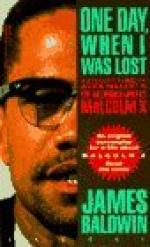|
This section contains 433 words (approx. 2 pages at 400 words per page) |

|
One Day When I was Lost: A Scenario Summary & Study Guide Description
One Day When I was Lost: A Scenario Summary & Study Guide includes comprehensive information and analysis to help you understand the book. This study guide contains the following sections:
This detailed literature summary also contains Bibliography and a Free Quiz on One Day When I was Lost: A Scenario by James Baldwin.
James Baldwin's screenplay One Day, When I Was Lost: A Scenario was adapted from Alex Haley's Autobiography of Malcolm X (1965). Although One Day, When I Was Lost: A Scenario was written as a movie script, it has never been produced solely on its own merits. One Day, When I Was Lost: A Scenario came closest to being realized on the screen in the documentaries Malcolm X (1972), co-written by Baldwin and Arnold Perl and the rewritten version by Spike Lee, Malcolm X (1992).
Malcolm X had been a friend and hero of Baldwin's, so it was with relish that Baldwin immersed himself in Haley's Malcolm X in his attempts to extrapolate a dramatic representation. At first, the script was supposed to have been written as a stage play in conjunction with Haley and Elia Kazan, a famous Broadway director. However, before the writing had begun, Columbia Pictures bought the movie rights of Haley's book and asked Baldwin if he would be interested in writing the screenplay.
Although urged by friends and family not to accept the Hollywood offer, Baldwin, who had always wanted to write a script for a movie and who also believed that he owed it to the memory of Malcolm X to write it, decided in Columbia's favor. He would regret his decision, as the movie studio's demands for changes in his script would frustrate his creative spirit and his sense of loyalty to his friend, Malcolm.
Baldwin's belief that Hollywood was ready for a truthful encounter with the facts of Malcolm X's life was soon diminished. One of Baldwin's strongest battles with the studio was fought over the starring role in the film. At one point, Columbia supposedly went so far as to suggest a white actor, who would be, according to Baldwin's biographer, David Leeming, "darkened up a bit" to portray the character of Malcolm X. After repeated communications from Columbia suggesting revisions in his script, Baldwin proclaimed that he would write it in his own words or not at all. In reaction, Columbia sent another writer, Arnold Perl, to collaborate with Baldwin. Baldwin resented this, believing that only he could be true to Malcolm X's story.
Adding to his depression and anger with Columbia was the assassination of Martin Luther King, Jr., which occurred in the middle of Baldwin's attempts to write the script. Shortly after King's assassination, Leeming states, Baldwin "took an overdose of sleeping pills." Upon recovering, Baldwin abandoned the dream of a Hollywood movie. Baldwin went on to finish One Day, When I Was Lost: A Scenario which was published in text form only.
Read more from the Study Guide
|
This section contains 433 words (approx. 2 pages at 400 words per page) |

|



